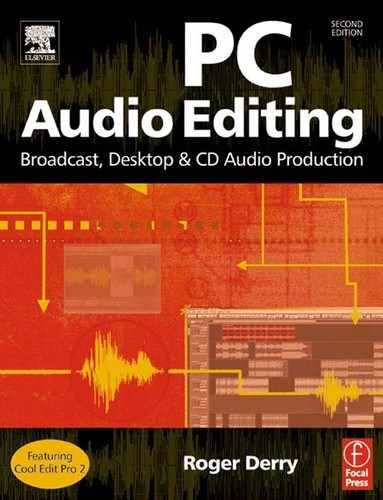Appendix 2
Clicks and clocks
When you copy digitally to your computer, are you plagued with clicks and plops? Is there a regular beating sound where there should be digital silence? If so, you are probably suffering from unsynchronized word clocks. Arcane though it sounds, the problem is simply solved.
Copying digitally from one device to another is, in many ways, easier than using an analogue link. There is no level adjustment to be made and quality is assured, provided the link is made by good quality cable.
Yet there is an extra factor that it is vital to get right, and this is what is known as word clock synchronization. You will be using 32 000, 44 100 or 48 000 samples per second sampling. These figures are also known as the word clock rate – 48 000 samples per second also means 48 000 digital words per second. For a 16-bit stereo signal each word will consist of two 16-bit samples (left and right) packaged together with additional ‘housekeeping’ data.
The word clock synchronizes the whole system; it can be thought of as the conductor of an orchestra. When you are copying from digital recorder to digital recorder, there are no complications. It is only when you have a device handling several digital signals at the same time – like a digital mixer or a computer sound card – that problems arise.
Returning to the conductor of an orchestra analogy, there are some pieces of music – Mahler symphonies, etc. – that feature offstage bands that cannot see the conductor in the hall. Unless something is organized, they will not be able to play in time with the hall orchestra. A common modern solution is to have a closed circuit TV connection, so that a second conductor can synchronize his beat to the image of the conductor in the hall.
So it is with digital systems. If your card can handle other inputs at the same time as the digital one, then you need to be concerned with word clocks. The ‘conductor’s beat’, aka the word clock, is sent as part of the digital signal – so we have our ‘closed circuit TV’. Normally the sound card will generate its own ‘beat’. This you set when you choose the sampling rate. While this is set to match the rate coming in from the external playback, there is no synchronization between the two. Even with crystal control the chances of both clocks being precisely the same frequency are remote, so every few seconds they drift one word apart. The error resulting from this is what causes the clicks or plops. The answer is to tell the sound card to ‘look’ at the word clock incoming from the DAT (or Minidisc) machine feeding it. The sound card management software should have this as an option, alongside the sampling rate selection.
Figure A2.1 shows dropdown menus for a multitrack card that can handle either optical or electrical digital inputs (the selection between the two is made in a separate menu).
If you select the S/PDIF or TOSLINK option, then the sound card is controlled entirely from the external bit stream; it will follow the sampling rate as part of the synchronization.

Figure A2.1 Dropdown menus for a multitrack card: (a) Toslink; (b) S/PDIF
Beware: you have to switch synchronization back to internal once you stop using the external machine. As soon as it is disconnected you will have no clock, and the sound card may either not produce any sound, or produce sound at the wrong rate and pitch.
Another trap is that an external machine may default to a different clock when it is not playing back. This means that, having very successfully copied a 44.1-kHz recording, the clock may go to 48 kHz when you take the DAT recording out. If you have not reset your sound card back to an internal clock setting, then the files played back through your editor may well play at the wrong speed and pitch – in this case, faster and higher.
Word clock in/out
The illustrated sound card can also synchronize to an incoming ADAT 8-track feed. It has another option, which is specifically labelled word clock. This is for a fully professional installation where a separate high quality word clock generator is used. This separately synchronizes a number of separate digital devices – essential when dealing with a digital mixer.
Equally, when you have more than one digital sound card you have to synchronize them by connecting the word clock output of the card you have designated as the master to the word clock in of the second card. The second card will always synchronize to the master provided it is set to use the word clock input, including following the sampling rate settings. If a third or fourth card is added, then the word clock can be ‘daisy-chained’ from output to input of the next. Word clock connections are usually made with professional video-style BNC connectors. They keep the cards in synch even when there are no audio data present.
